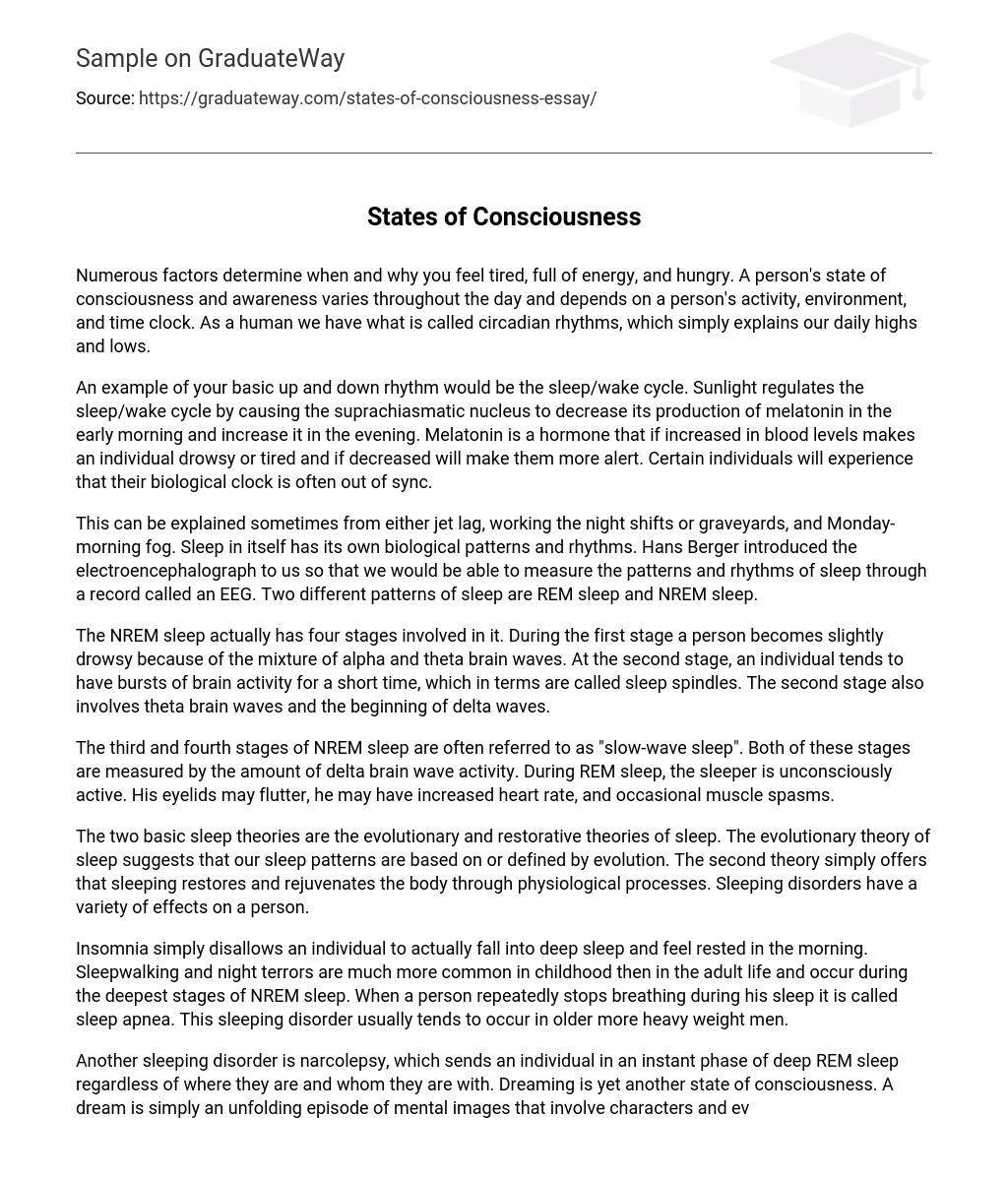Various elements, including daily activities, surroundings, and internal body clock, influence an individual’s fatigue, energy levels, and hunger. These changes in consciousness and awareness are regulated by the circadian rhythms that humans undergo.
The sleep/wake cycle is influenced by sunlight and follows a predictable pattern. Sunlight impacts the suprachiasmatic nucleus, which controls the production of melatonin. In the morning, sunlight decreases melatonin levels, while in the evening it raises them. Melatonin is a hormone that induces sleepiness when its levels are high and enhances alertness when they are low. Certain individuals frequently experience disturbances in their biological clock.
This phenomenon can be attributed to various factors such as jet lag, night shifts, graveyards, and the lethargy commonly experienced on Monday mornings. Sleep possesses its own intrinsic biological patterns and rhythms, which were first quantified by Hans Berger through the electroencephalograph (EEG). This device allows us to observe and analyze the sleep patterns and rhythms, with two distinct types being REM sleep and NREM sleep.
The NREM sleep is comprised of four stages. In the first stage, a person experiences slight drowsiness due to a combination of alpha and theta brain waves. The second stage is characterized by brief bursts of brain activity known as sleep spindles. This stage also involves theta brain waves and the onset of delta waves.
The third and fourth stages of NREM sleep, which are also referred to as “slow-wave sleep”, display delta brain wave activity. Meanwhile, during REM sleep, the person remains still but encounters involuntary eye movement along with a rise in heart rate and sporadic muscle spasms.
There are two primary theories regarding sleep: the evolutionary theory and the restorative theory. The evolutionary theory claims that our sleep patterns are influenced by evolution, while the restorative theory proposes that sleep is essential for the body to restore and rejuvenate itself through physiological processes. Sleeping disorders can have diverse effects on individuals.
Insomnia prevents people from entering deep sleep and feeling refreshed in the morning. Sleepwalking and night terrors are more prevalent during childhood, particularly during the deepest stages of NREM sleep. Sleep apnea, characterized by recurrent instances of interrupted breathing during sleep, typically affects older, overweight men.
Narcolepsy is a sleep disorder that causes sudden onset of deep REM sleep, regardless of the environment or people present. Dreaming is an altered state of consciousness where mental images of characters and events unfold. While dreams typically occur during REM sleep, they can also happen during NREM sleep.
Dreaming is an intriguing occurrence that encompasses various subjects and people. The precise comprehension and explanation of dreams remain a mystery, captivating individuals with their enigma and source. Nightmares, a disturbing type of dream, elicit intense anxiety and feelings of helplessness due to their vivid and lifelike quality.
Both lucid dreams and hypnosis result in altered states of consciousness. In a lucid dream, the dreamer is conscious and may have control over the dream. Hypnosis, however, is a disputed state that can impact perception, memory, and behavior. It is important to acknowledge that not everyone can be hypnotized; nonetheless, individuals with a positive outlook are more inclined to be susceptible to it.
During deep hypnosis, individuals experience detachment from their physical bodies or a deep sense of relaxation, leading to major changes in their conscious experience. After the hypnosis session, if given a suggestion, they will temporarily or even for several days adhere to it. Ernest Hilgard’s theory states that during hypnosis, consciousness separates into multiple streams of mental activity, causing dissociation. Psychoactive substances are chemical compounds that alter emotions, perceptions, and an individual’s level of consciousness.
The continuous misuse of psychoactive substances results in the body developing a physical dependence on and tolerance to them, leading individuals to consume more in order to achieve desired effects. Discontinuing drug use often triggers withdrawal symptoms. The main types of psychoactive drugs include depressants, opiates, stimulants, and psychedelic drugs. Depressants have the capability to decrease and slow down brain activity.
Alcohol, a legal depressant drug, has different properties from illegal drugs but produces similar effects to other depressants like barbiturates, tranquilizers, and inhalants. Barbiturates and tranquilizers are employed for anxiety relief and sleep promotion, whereas inhalants cause altered consciousness by inhaling chemical substances.
The text states that opiates, including heroin, morphine, and Demerol, belong to the second category of drugs. These substances have the capability to produce euphoria in people. Another category of psychoactive drugs is stimulants like caffeine and nicotine, which greatly affect today’s society.
Many people regularly consume legal substances like coffee, sodas, tea, and cigarettes. These substances are often abused because they are legal. Stimulants such as cocaine and amphetamines produce similar effects, including appetite suppression, increased euphoria, heightened mental alertness, and enhanced self-confidence.
The drug’s addictive nature is evident in the swift shift from depression to excitement once the initial euphoria subsides. Another type of drug, LSD, triggers hallucinations with different effects depending on an individual’s personality. Each person’s level of consciousness is influenced by their activities, dreams, and decisions.
Each individual possesses their own biological clock and circadian rhythms, which can either operate correctly or be disturbed by not adhering to the regular passage of time.





